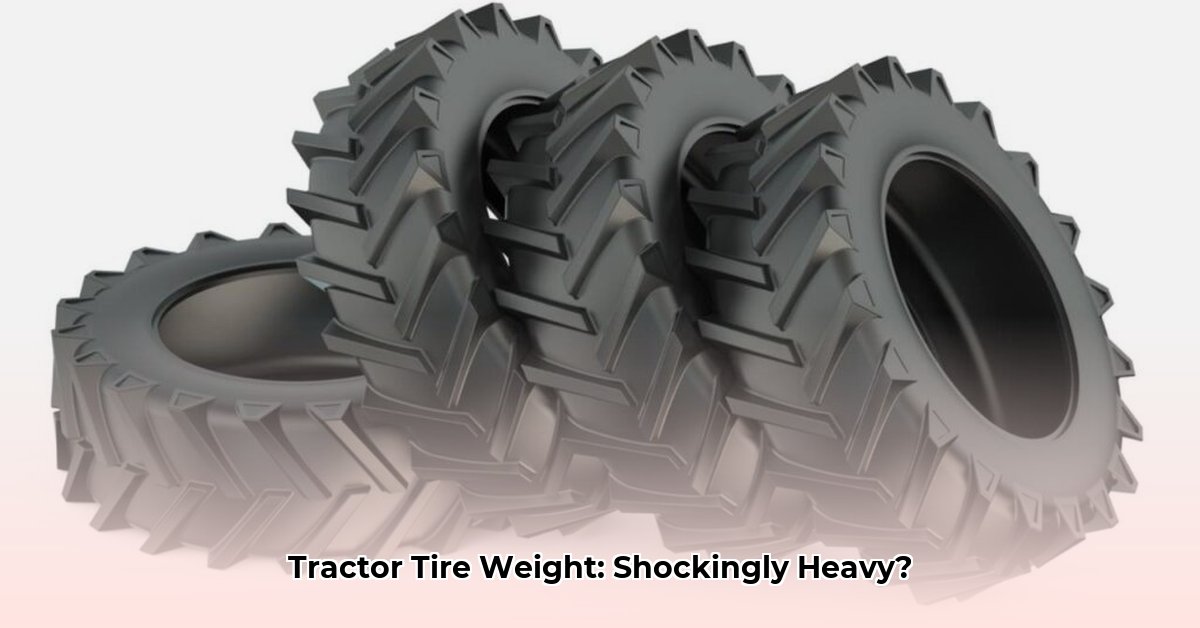
Why Tire Weight Matters: Fuel Efficiency, Traction, and Soil Health
The weight of your tractor tires isn't just a number; it significantly impacts your farm's efficiency and long-term sustainability. Choosing the right tire weight is crucial for optimizing several key aspects of your operation. Let's explore why:
For more detailed information on tire weights, check out this helpful resource: Tire Weight Guide.
Fuel Efficiency: Heavier-than-needed tires increase rolling resistance, leading to higher fuel consumption. Lighter tires, however, might compromise traction, potentially increasing fuel usage through slippage. Finding the optimal balance is essential for minimizing fuel costs. A study by the University of Nebraska-Lincoln showed that properly inflated tires can improve fuel efficiency by up to 10%.
Traction: Adequate tire weight provides the necessary grip for various field operations, especially in challenging conditions like mud or hills. Insufficient weight leads to slippage and reduced productivity. Conversely, excessive weight may not proportionally improve traction and can damage the soil.
Soil Compaction: Heavy tires compact the soil, reducing water infiltration, aeration, and root penetration. This negatively affects crop yields and overall soil health. Choosing lighter tires for appropriate situations directly reduces this risk. Research from the USDA indicates that soil compaction can decrease crop yields by 15-20%.
Factors Affecting Tractor Tire Weight: Size, Type, and More
Several factors significantly influence the weight of a tractor tire:
Tire Size: Larger tires invariably weigh more due to their increased volume and materials. A 18.4R38 tire will inherently weigh more than a 11.2R24 tire.
Tire Type (Radial vs. Bias-Ply): Radial tires are generally lighter than bias-ply tires for the same load capacity, but their sidewall flexibility can impact performance in certain applications. Remember to evaluate the balance of weight and performance for your specific farming needs.
Manufacturer: Different manufacturers employ varying manufacturing processes and materials, resulting in weight differences even among tires with identical specifications. Always refer to the manufacturer's specifications for precise weight data.
Construction: Features like additional layers for puncture resistance or reinforced sidewalls increase overall tire weight. These features, while adding weight, can also significantly enhance tire life and durability.
Approximate Tire Weights (lbs): Please note that these are estimates; consult manufacturer specifications for precise weights.
| Tire Size | Manufacturer A (Radial) | Manufacturer B (Bias-Ply) | Manufacturer C (Radial) |
|---|---|---|---|
| 16.9R38 | 850 | 900 | 875 |
| 18.4R38 | 1000 | 1050 | 1020 |
| 11.2R24 | 420 | 450 | 430 |
Determining the Right Tire Weight: A Step-by-Step Guide
Choosing correctly requires a systematic approach:
Assess Your Tractor: Consider its size, horsepower, and intended applications. Larger tractors often require heavier tires.
Identify Your Primary Tasks: Heavy hauling demands more robust tires than lighter fieldwork. Consider the intensity of the task and its impact on the chosen tire's life and structural strength.
Analyze Your Terrain: Challenging terrains (rocky, hilly) necessitate tires prioritizing stability and traction, often favoring heavier options. Lighter soils allow for generally lighter tires to minimize compaction.
Check Local Regulations: Adhere to any weight restrictions for roads and fields in your area to avoid penalties.
Risk Assessment Matrix (Qualitative):
| Tire Weight | Suitable Terrain | Impact on Fuel Efficiency | Impact on Soil Compaction |
|---|---|---|---|
| Underweight | Light, flat land | Low (potentially higher) | Low |
| Optimal Weight | Diverse terrains | Optimal | Moderate |
| Overweight | Challenging terrain | High | High |
Tire Management and Maintenance: Maximizing Tire Lifespan
Proper maintenance is key to maximizing tire lifespan and performance:
Inflation Pressure: Maintain the manufacturer's recommended inflation pressure. Improper inflation leads to increased wear, reduced fuel efficiency, and potential tire failure. A TPMS (Tire Pressure Monitoring System) helps in maintaining optimal inflation.
Regular Inspections: Regularly inspect your tires for cuts, bulges, or unusual wear patterns. Address any issues promptly to prevent further damage.
Tread Depth: Monitor tread depth and replace tires when it falls below the recommended minimum. Worn tires reduce traction and increase the risk of accidents.
Future Trends and Considerations: Sustainable Tire Technology
Ongoing advancements focus on lighter, more durable materials, improved tread designs for better traction and longer life, and more sustainable rubber compounds. Staying informed about these developments allows farmers to make informed decisions that combine performance, economy, and environmental responsibility.
Conclusion: The Importance of Correct Tractor Tire Weight
Selecting the right tractor tire weight is critical for fuel efficiency, traction, soil health, and overall operational success. By understanding the factors influencing tire weight, following a systematic selection process, and adhering to proper maintenance practices, farmers can ensure optimal performance and long-term sustainability.